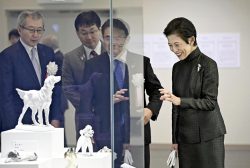
Brushes made with hair from animals, including, from left, red panda, Pere David’s deer, chimpanzee and flamingo.
14:08 JST, December 22, 2022
KUMANO, Hiroshima — While sitting at his workshop table, Masaki Sanemori picks up and closely examines a clump of what looks like fine brown threads. This traditional craftsman in the town of Kumano, which is known as Japan’s largest brush production area, has a new material for brush bristles — red panda hair.
“It has different thicknesses and hardnesses,” Sanemori, 48, said with a wry grin. “It’s frizzier than normal hair, and it has kinks. Using this will be a challenge.”

Masaki Sanemori makes a brush from red panda hair, left, The process used by Sanemori to make a brush
A zoo provided this hair, which was shed by a red panda, to Sanemori. Traditional, handmade brushes from Kumano, called kumanofude in Japanese, conventionally used the hair of animals such as goats, deer and weasels.
“Most of the hair is imported from China, and is a by-product of animals used for food,” said Kenji Shiromoto, managing director of the Kumanofude Cooperative.
“No animals are sacrificed just to make brushes,” Shiromoto said.
Increased awareness of animal welfare in recent years has made acquiring animal hair more difficult. But at the same time, the growing adoption of sustainable development goals set by the United Nations has resulted in greater emphasis being placed on craftsmanship that uses materials which could be returned to nature. Relying solely on synthetic fibers would become problematic.
Three years ago, the cooperative launched a campaign promoting kumanofude made from hair shed by animals as a traditional craft that is cultivating a new approach and gentle on the environment. The cooperative receives the hair —and in some cases, feathers — of six kinds of animals, including flamingos, chimpanzees and giraffes, from the Asa Zoological Park in Hiroshima City.
Kumanofude date back to the late Edo period (1603-1867) and started as a new industry for Kumano, which had little farmland. Production peaked after World War II, but has since steadily declined due to the nation’s falling population, fewer people being interested in calligraphy, and the increase in cheap brushes made in China. Even so, about 10% of Kumano’s 23,500 or so residents still work in the industry.

A makeup brush popular with women
There are over 70 steps in the production process to create one kumanofude brush. These include hair selection, making the shaft and the finishing touches. The bristles feel delicate and soft because the hair tips are uncut.
“Rather than ‘painting’ with a paintbrush, our calligraphy and makeup brushes make it feel like you are gently drawing,” said Shin Takemori, chairman of the cooperative.
The cooperative hopes to eventually increase the kinds of animal hair used in kumanofude, and it will create new designs and hold workshops at which children can try making brushes. The future being drawn by kumanofude is certainly bristling with potential.
"Culture" POPULAR ARTICLE
-

Van Cleef & Arpels Dazzles with Art Deco Artisanry at Tokyo Exhibit
-

Disney’s ‘Twisted-Wonderland’ Animated Series Puts Villains in Spotlight: New Show Features School Inspired by Classic Disney Films
-

Japan Plans to Distribute Manga Overseas Via New Platform
-

Ayumi Hamasaki’s Shanghai Concert Canceled Day Before Schedule as Part of Beijing Backlash
-

‘The World Masterpiece Theater Series’ Celebrates 50 Years; Animator Looks Back on Creating Anime Classics
JN ACCESS RANKING
-

Tokyo Economic Security Forum to Hold Inaugural Meeting Amid Tense Global Environment
-

Keidanren Chairman Yoshinobu Tsutsui Visits Kashiwazaki-Kariwa Nuclear Power Plant; Inspects New Emergency Safety System
-

Imports of Rare Earths from China Facing Delays, May Be Caused by Deterioration of Japan-China Relations
-

University of Tokyo Professor Discusses Japanese Economic Security in Interview Ahead of Forum
-

Japan Pulls out of Vietnam Nuclear Project, Complicating Hanoi’s Power Plans




























